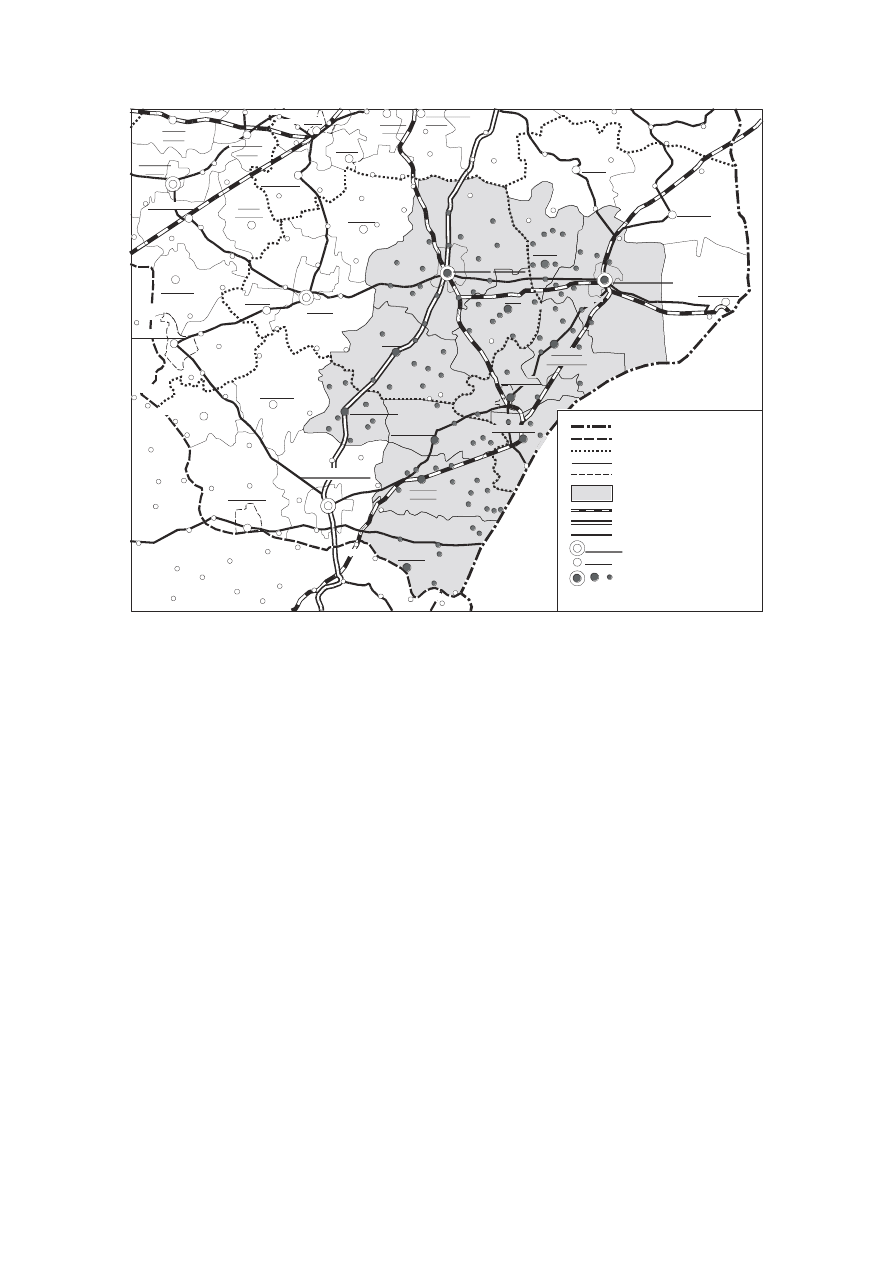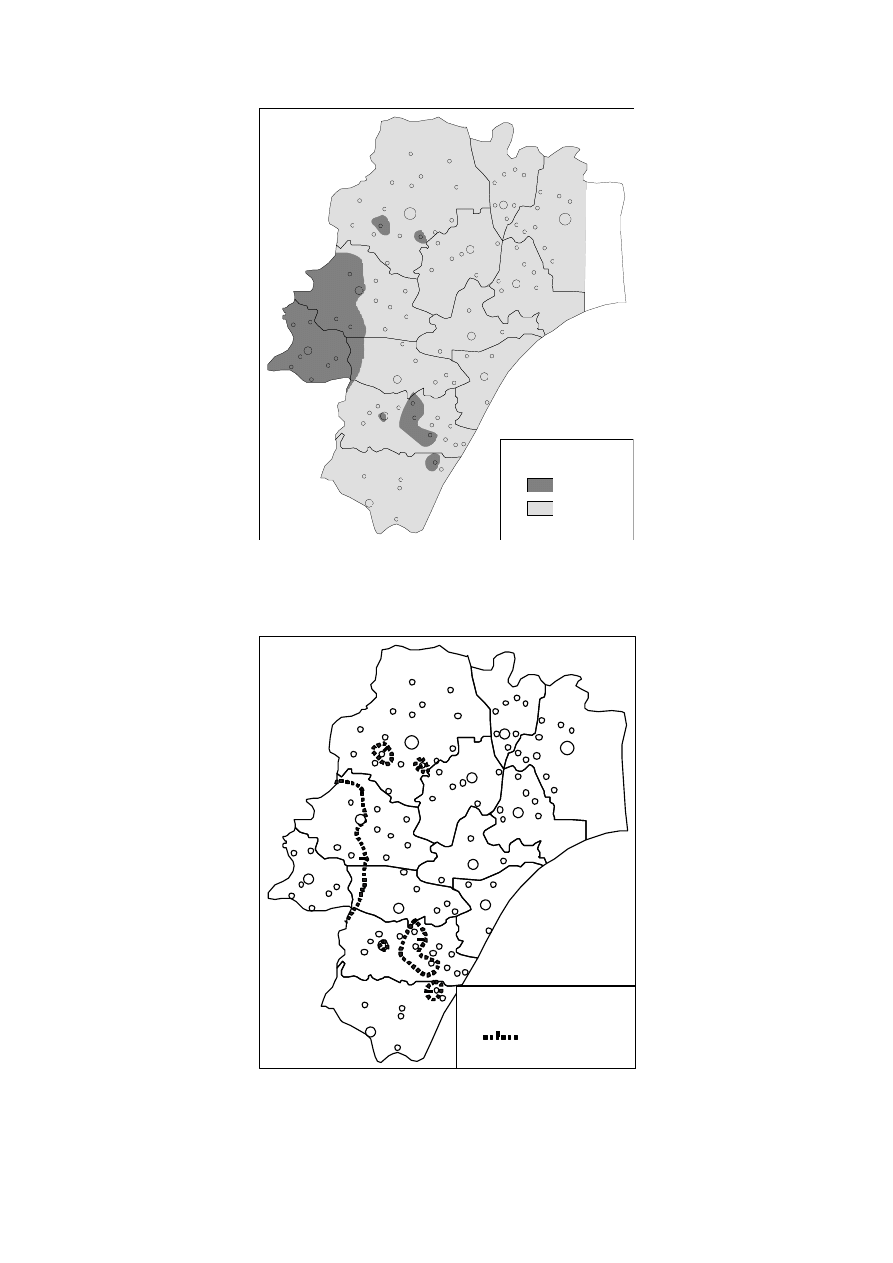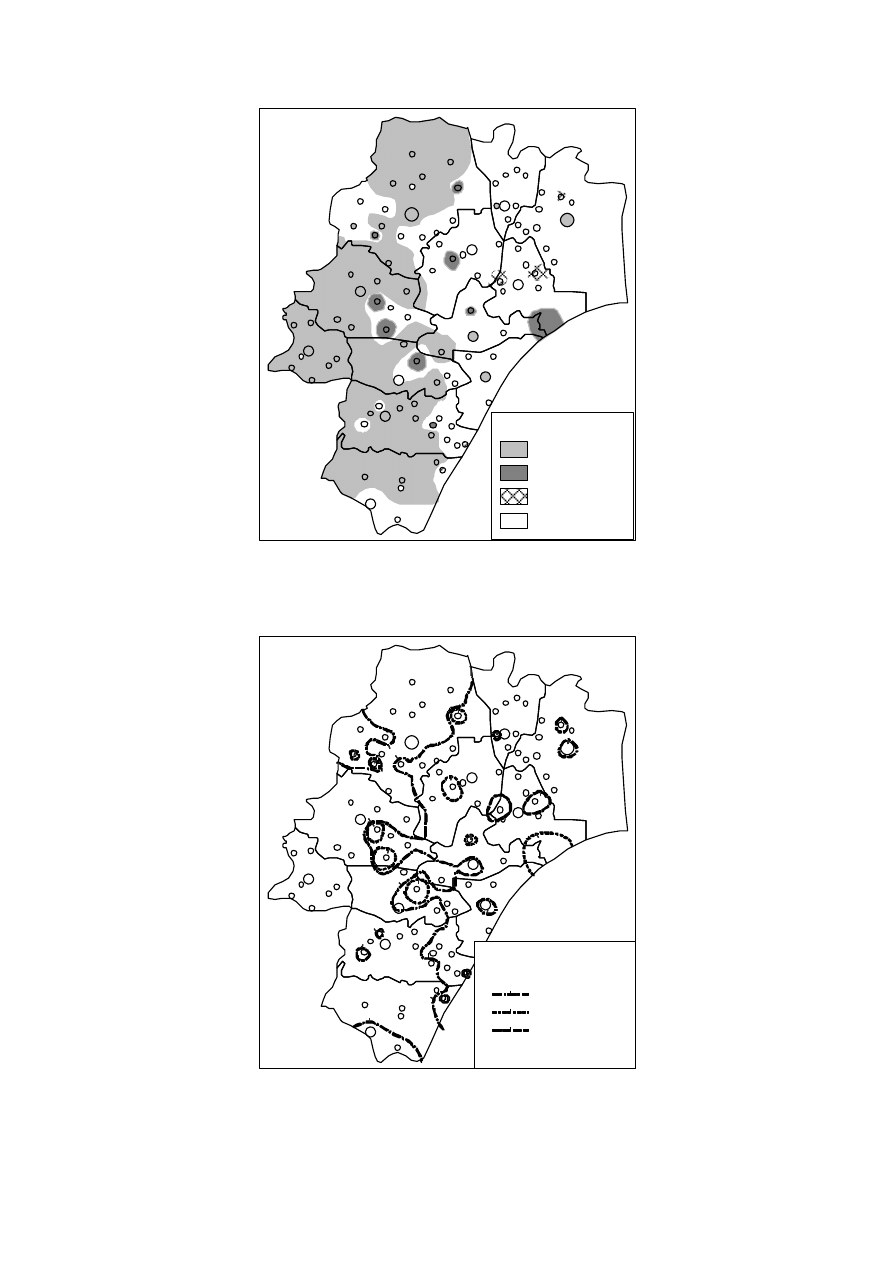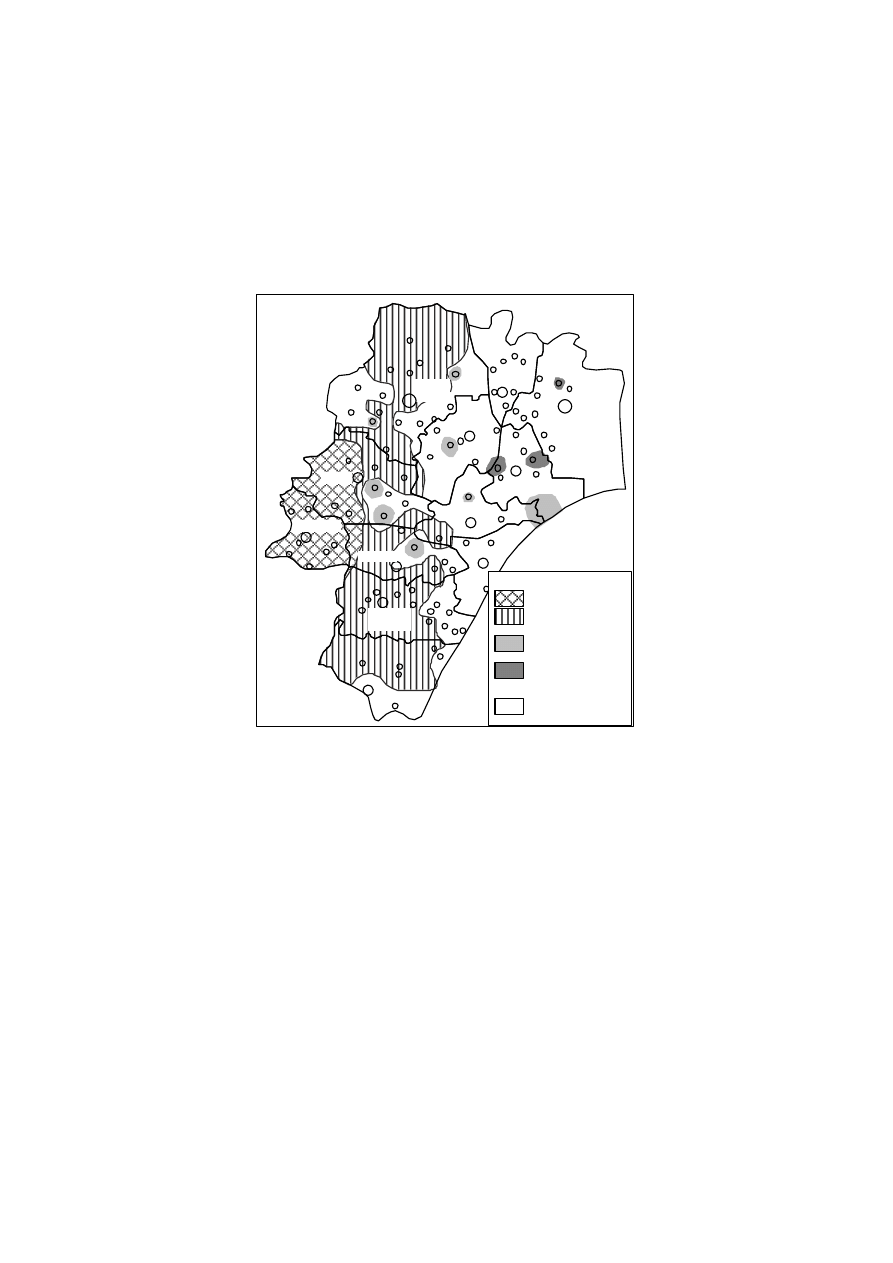
1
Marek BARWIŃSKI
University of Łódź, POLAND
No 7
THE CONTEMPORARY ETHNIC AND RELIGIOUS
BORDERLAND IN THE PODLASIE REGION
Podlasie, a historical and geographical region in eastern Poland, has been for centuries a
political and national borderland where Polish, Lithuanian, Belorussian and Ukrainian ethnic
elements intermingled. This resulted in a very durable ethnic, religious and cultural
borderland in Podlasie. It was formed by a number of ethnic and religious communities that
inhabited this region since a remote past and influenced each other thus making of the region
a maze of nations, religions, languages and cultures. The ethnic and religious diversification
of the region was determined by frequent changes in political attachment of Podlasie and
several waves of various settlement – a usual phenomenon in the region that was, particularly
in the Middle Ages, a kind of frontier of Poland, Lithuania and Russia (Gloger 1903,
Makarski 1996, Piskozub 1968, 1987, Ślusarczyk 1995, Wiśniewski 1977).
Ethnic borderland in Podlasie is the most diversified region in Poland in respect of
nationality, culture and religion. It forms both an interstate borderland between Poland and
Belarus and an internal ethnic, religious, cultural and linguistic borderland. Prevailing nations
are Poles and Belorussians but the presence of Ukrainians, Lithuanians, Tatars, Romanies,
Armenians, Russians, and Karaites makes of the region a maze of nations. The religious
mosaic is not so striking, nevertheless it is the only province of Poland where the Roman
Catholics are outnumbered by followers of another religion, namely the Orthodox
(Chałupczak, Browarek 1998, Sadowski 1991 a, 1995 a, b, 1997).
The national and religious borderland in Podlasie is a zone with many transitory areas
where different national, religious, linguistic and cultural groups overlap. There are hardly
any clear dividing lines separating particular national and religious groups. In Podlasie
various communities, in many cases closely related to each other, coexist side by side.
Zone borderlands are usually extensive areas where ethnic divisions tend to fade away. The
whole area of north-eastern Poland, including Podlasie, can be considered as such a zone
borderland. Here, several nationalities and religions are separated by more or less vast

2
transitory belts rather than definite dividing lines. Sometimes such transitory areas gave rise
to some new derivative communities (Chlebowczyk 1975, 1983, Koter 1995, 1998, Sadowski
1991a, b, 1995 a, 1997).
Notwithstanding these difficulties, the paper seeks to define the areas of domination of
particular national and ethnic groups in south-eastern Podlasie and to demarcate national and
religious borderlands in the area concerned. This attempt encountered a number of obstacles,
some of them being specific for the region of Podlasie
1
, such as:
-
high degree of national and religious diversification of the region’s population and its
mobility;
-
unconformity of declared nationality with religion and mother tongue stereotypically
ascribed to it;
-
religious, cultural and linguistic closeness of Belorussian and Ukrainian populations;
-
lack of evident natural geographic borders between the communities concerned;
-
post-war population shifts resulting from migration to the towns, particularly the East-
Slav Orthodox population;
-
assimilation and Polonization of the Orthodox population, intensified by post-war
migrations, socio-economic advances of rural population and the policy pursued by the
communist government toward national minorities;
-
a kind of Ruthenization of a small part of Orthodox population causing some
controversies and clashes concerning ethnic origin (Belorussian or Ukrainian) of the
Orthodox population inhabiting the area between the Narew and Bug rivers;
-
big share (20%) of people who avoid a definite national declaration labelling themselves
“locals” (“tutejsi”), particularly among the Orthodox.
For lack of official statistical data (at the time of the survey) on national and religious
composition of the Podlasie population the borderland was demarcated according to
subjective declarations of national and religious identity of the respondents. Sample of
1,500 respondents
2
was taken from 3 towns and 103 villages situated in 12 communes in
south-eastern Podlasie (fig. 1).
1
For more details see Barwiński M., 2004, ‘Podlasie jako pogranicze narodowościowo-wyznaniowe’, Łódź
2
The questionnaire survey was carried out using the standardised interview method. Sample selection was made
by proportional quota method. The proportion 2 interviews per 100 inhabitants was adopted for rural areas and 1
interview per 100 inhabitants for urban areas. Sample closely represented the total population as the age-sex
structure is concerned.

3
Kołaki
Kośc.
Kleszczele
Pedejewo
Grodzisk
Dziadkowice
BIELSK PODL.
HAJNÓWKA
SIEMIATYCZE
Drohiczyn
Ciechanowiec
Wysokie
Maz.
Łapy
Brańsk
Klukowo
Rudka
Szepietowo
Nowe
Piekuty
Poświętne
Wyszki
Suraż
Kulesze
Kośc.
Turośń
Kośc.
Juchnowice
Kośc.
Narew
Czyże
Narewka
Białowieża
Boćki
Orla
Dubicze
Cerkiewne
Nurzec
-Stacja
Milejczyce
Mielnik
Czeremcha
Rybaki
Rybaki
Nowa
Wola
Juszkowy Gród
Szymki
Lewkowo
Grudki
Siemianówka
Nowosady
Dubiny
Witowo
Dobrowoda
Istok
Korciska
Dubicze
Osoczne
Czyżyki
Nowy
Kornin
Stary
Kornin
Nowe
Berezowo
Stare
Berezowo
Orzeszkowo
Pasieczniki
Duże
Grabowiec
Wojnówka
Suchowolce
Dasze
Kuzawa
Czeremcha
Wieś
Wólka
Terech.
Połowce
Rogacze
Nurzec
Nurzec
-Wieś
Augustynka
Tymianka
Wólka
Nurz.
Zubacze
Żerczyce
Tołwin
Wiercień
Duży
Zajęczniki
Słochy
Annopolskie
Bogawka
Miłkowice
-Mańki
Ostrożany
Putkowice
Nadolne
Tonkiele
Głęboczek
Granne
Moczydły
-Kukiełki
Czaje
Czarna
Wlk.
Pobikry
Trzaski
Malec
Boguty
-Pianki
Bujenka
Kuczyn
Wyszonki
Kośc.
Dąbrowa
Wlk.
Dąbrowice
Moczydły
Dąbrowice
Dzięciel
Dąbrówka
Kośc.
Jabłoń
Kośc.
Wyliny-Ruś
Mazury
Brok
Wnory
-Wypychy
Uhowo
Grabarka
Sycze
Klukowicze
Litwinowicze
Siemichocze
Zalesie
Wyczółki
Tokary
Mętna
Sutno
Wilanowo
Adamowo
-Zastawa
Radziwiłłówka
Krasna Wieś
Nurzec
Koszele
Szrenie
Reduty
Rutka
Krywiatycze
Spiczki
Wandalin
Osmolin
Zaręby
Malinowo
Szeszyły
Andryjanki
Śnieżki
Sasiny
Knorydy
Dubno
Bystre
Dziecinne
Jakubowskie
Lewki
Piliki
Grabowiec
Augustowo
Parcewo
Hołody
Orzechowicze
Pasynki
Gredele
Malinnik
Zbucz
Leniewo
Podrzeczany
Rakowicze
Mochate
Klejniki
Lady
Osówka
Kuraszewo
Tylewicze
Małe
Łosinka
Trześcianka
Pawły
Ryboty
Koźliki
Turośń
Dln.
Biele
Tryczówka
Zawyki
Doktorce
Strabla
Mułowicze
Filipy
Pulsza
Płoski
Chraboty Zubowo
Kotły
Stryki
Szastały
Bolesty
Proniewicze
Hryniewicze Duże
Olędy
Puchały Stare
Potoki
Świdry
Kiewłaki
Topczewo
Malicze
Kalnica
Niemirów
Mierzwice
Sarnaki
Serpelno
N. Hołowczyce
Łysków
Rusków
Platerów
Dąbrowa
Stary Bartków
Korczew
Drażniew
Mężenin
Paprotnia
Sawice Wieś
Repki
Skrzeszew
Czekanów
Gródek
Jabłonna
Lacka
Dzieżby
Włościańskie
Kamieńczyk
Białobrzegi
Płonka
Kośc.
Osse
Reszki-Wodźki
St. Brzozowo
Piętkowo
Klichy
Dołubowo
Smolugi
Hornowo
Białki
Miedwieżyki
Mikulicze
Nowosiółki
Jasieniówka
Żurobice
Kajanka
Fronołów
B I A Ł O R U Ś
W O J . M A Z O W I E C K I E
LUB.
BIELSK
granice państw
granice województw
granice powiatów
granice miast i gmin
granice miast połączonych
z gminami
drogi główne jednojezdniowe
drogi drugorzędne jednojezdniowe
linie kolejowe
miasta powiatowe
wsie gminne
woj. lubelskie
miejscowości objęte
badaniami ankietowymi
obszar badań
Mielnik
LUB.
Gnojno
Fig. 1. The research area – localities comprised in the survey
The estimates of national and religious composition of each settlement were based
exclusively on respondents’ declarations. The next step consisted in spatial interpolation of
the results obtained. The graphic representation, performed by the MapInfo Professional
programme, portrays geographical distribution of ethnic and religious groups, their share in
the total population within given parts of the area concerned, and areas of domination (over
50% share) of particular ethnic and religious groups (fig. 2, 4). This constituted the base for
demarcation of borders between dominating religious and ethnic groups (fig. 3, 5).
Naturally, the ethnically and religiously diversified borderland exceeds the extent of the
Podlasie region and occurs in whole north-eastern Poland. Delimitation of the ‘borderland of
domination’ refers to a much narrower zone where the share of individual ethnic or religious
communities diminishes from over 50% (which means a domination of a given group) to less
than a half (which means a domination of another group or non-domination of any group).

4
CZEREMCHA
BOĆKI
DUBICZE
CERKIEWNE
KLESZCZELE
ORLA
HAJNÓWKA
CZYŻE
MIELNIK
DZIADKOWICE
MILEJCZYCE
BIELSK
PODL.
NURZEC
-STACJA
Catholics
Orthodox
More than 50%
Fig. 2. Areas of religious domination
CZEREMCHA
BOĆKI
DUBICZE
CERKIEWNE
KLESZCZELE
ORLA
HAJNÓWKA
CZYŻE
MIELNIK
DZIADKOWICE
MILEJCZYCE
BIELSK
PODL.
NURZEC
-STACJA
more than 50% Poles
more than 50% By elorussians
Borderland between:
Fig. 3. Geographical position of borderland between the areas of religious domination

5
CZEREMCHA
BOĆKI
DUBICZE
CERKIEWNE
KLESZCZELE
ORLA
HAJNÓWKA
CZYŻE
MIELNIK
DZIADKOWICE
MILEJCZYCE
BIELSK
PODL.
NURZEC
-STACJA
Poles
Belorussians
"local inhabitants"
More than 50%
No dominating
ethnic group
Fig. 4. Areas of ethnic domination
CZEREMCHA
BOĆKI
DUBICZE CERKIEWNE
KLESZCZELE
ORLA
HAJNÓWKA
CZYŻE
MIELNIK
DZIADKOWICE
MILEJCZYCE
BIELSK
PODL.
NURZEC
-STACJA
more than 50%
Poles
By elorussians
"local inhabitants"
and less than 50%
Borderland between:
Fig. 5. Geographical position of borderland between the areas of ethnic domination

6
Geographically and historically, the most striking characteristic of the borderland in
question is its amazing stability: during a very long period it changed very little. First contacts
between Polish and Ruthenian populations in Podlasie took place in the early Middle Ages,
probably near the Nurzec River. Nevertheless a clear division between Catholic Poles and
Orthodox Ruthenians formed only in the late 15
th
century much further eastward, along
Drohiczyn-Boćki-Samułki line. This shift was caused by devastating Tatar raids and
progressing Polish colonization coming from the west. Obviously, on both sides of this border
there were mixed areas. The highest degree of national and religious diversification was
typical of towns and their vicinities. Censuses made a few centuries later (in 1897, 1921, and
1931) showed that the ethno-religious division of Podlasie had persisted since the 16
th
century: the west was inhabited by Catholic Poles whereas the east was predominantly
Ruthenian and Orthodox in religion. The border separating them remained almost unchanged
since the 15
th
and 16
th
centuries, except in the southern part, on the Bug River, it shifted
slightly eastward. In the inter-war period this border ran approximately along the line:
Siemiatycze-Milejczyce-Boćki-Bielsk-Plutycze. On both sides of this line, however, there
were towns and villages inhabited by mixed population, mainly on the eastern side (Goss
2001, Hawryluk 1993, 1999, Krysiński 1928, Makarski 1996, Wakar 1917, Wiśniewski 1977).
Recent researches have shown that at the turn of the 20
th
century the Catholic-Orthodox
borderland remains alive and well in Podlasie without any significant changes over the last
500 years. The division of Podlasie into the predominantly Catholic western part and mostly
Orthodox eastern part has existed for a few centuries. It is worth noting that the border still
runs more or less along the line: Siemiatycze – Milejczyce – Boćki – Bielsk Podlaski.
Moreover the researches have confirmed that in the southern part, on the Bug River, the
religious borderland tend to shift eastward. On the eastern Orthodox part of the area concerned
relatively the largest share of Catholic population occurs only in towns.
It may be stated that the historical religious diversification of the Podlasie population is
still very steady and religious identity – Orthodox and Catholic alike – is definitely the most
important element defining their sense of self-identity.
National borderland in Podlasie reaches much further to the east compared to religious
borderland (fig. 2, 4). The extents of these two borderlands differ greatly, mainly because
many Polish respondents (nearly a half) declares affiliation to the Orthodox Church. This
refers particularly to rural areas where ‘Pole-Orthodox’ is the prevailing category declared by
the respondents (Barwiński 2004 a, b). This category is mostly made up of Polonized people
of Belorussian or Ukrainian background who, in spite of self-identification with Polish nation,

7
have preserved Orthodox religion, which is not related with Polishness. This results from
domination of conservative rural society with relatively large proportion of elderly people
who identify themselves by the ‘religion of forefathers’ rather than language or nationality.
Moreover, it should be stressed that differences between the two religions consist not only in
theological questions but include some cultural, social and traditional issues. These
differences appear even in electoral behaviour as most of the Orthodox – irrespectively of
their nationality – vote for the leftist parties. Therefore attachment to the Orthodox
community means more than just religious identity; this also has some implications
concerning culture, tradition, mentality and specific life style (Kowalski 1998, 2000,
Pawluczuk 1999, Sadowski 1995 a).
Some inhabitants of Podlasie, mainly Orthodox, are characterised by changeable national
and linguistic identity. It undergoes some changes that consist, in most cases, in assimilation
with dominant Polish society. Therefore the contemporary national divisions in Podlasie do
not conform to the linguistic and particularly the religious ones (Barwiński 2001 a, b, 2004).
It is clearly visible that the area dominated by Polish nationality is larger than the extent of
Roman Catholicism (fig. 2, 4). Predominantly Polish area covers the whole north-western,
western and south-western part of the territory in question. Its easternmost extreme is in the
southern part where it nearly reaches Polish-Belorussian state border. From this it appears that
the respondents who declare themselves as Poles-Orthodox are mostly in central part of the
area concerned (fig. 6).
In eastern and north-eastern part of the research area there is no dominant group. Although
in some villages Belorussians or ‘locals’ (tutejsi) as well as Poles are prevailing, mainly in
towns, nevertheless in most of the area none national group accounted for more than 50% of
respondents (fig. 4). It proves a considerable ethnic diversity of this region. Although none
community has an absolute domination, nevertheless the Orthodox population prevails,
mainly the ‘locals’ (tutejsi) and to a lesser extent the Belorussians. The geographical
distribution of these two communities is very similar. The main difference consists in a
marked correlation between the distribution of Belorussians and the Orthodox. On the areas
utterly dominated by the Catholics, especially in western and southern part, the share of
Belorussians is quite insignificant.
The proportion of those declaring Ukrainian nationality is negligible. Almost all over the
area concerned the Ukrainian national identity does not occur or make up merely a few
percent of the total. The questionnaire survey carried out during the research failed to provide

8
evidence of a clear Polish-Ukrainian or Belorussian-Ukrainian borderlands, although Ukrainians
no doubts constitute a component of national composition of Podlasie population.
The region of Podlasie is characterised by national and, more rarely, religious enclaves,
particularly in central and north-eastern part. The most ethnically diversified sector is found in
the central part of the research area, which has a transitory character (fig. 6).
CZEREMCHA
BOĆKI
DUBICZE
CERKIEWNE
KLESZCZELE
ORLA
HAJNÓWKA
CZYŻE
MIELNIK
DZIADKOWICE
MILEJCZYCE
BIELSK
PODL.
NURZEC
-STACJA
Poles and Catholics
More than 50%
Poles and Orthodox
Belorussians
"local inhabitants"
No dominating
religiouse-ethnic
group
and Orthodox
and Orthodox
Fig. 6. Areas of religious and ethnic domination
The research has confirmed that the national and religious spatial diversification of
Podlasie population with two totally different parts: western and eastern, remained basically
unchanged for centuries.
A new tendency, increasingly noticeable especially after WW II, is national borderland
shifting eastward faster than the religious one, which results in growing unconformity of the
two borderlands. It is explicable in terms of progressing Polonization (in some cases leading
to acculturation) of many Orthodox, who, however, preserve their faith. In consequence these
days a large part of Polish population in Podlasie declares Orthodox religion. It follows that
the predominantly Polish area is more extensive than the area of Catholic domination, which
causes divergences between national and religious borderland.

9
Although the two borderlands are not in line, the analysed part of Podlasie region is
evidently divided, both ethnically and religiously, into two parts: the western part dominated
by Polish Catholic population and the eastern part dominated by adherents of the Orthodox
Church more diversified as to their nationality. The central part is predominantly inhabited by
Polish Orthodox population, while in the north-eastern part none of the groups has absolute
domination but the communities of ‘tutejsi’ and Belorussians are most numerous (fig. 6).
Bibliography:
1. Barwiński M., 2001 a, Contemporary National and Religious Diversification of Inhabitants of the Polish-
Belorussian Borderland – the Case of the Hajnówka District, [in:] Koter M., Heffner K. (ed.), Changing
Role of Border Areas and Regional Policies, „Region and Regionalism”, no. 5, Łódź-Opole, pp. 180-184.
2. Barwiński M., 2001 b, Stereotypy narodowościowo-religijne na Podlasiu, [in:] Lesiuk W., Trzcielińska-Polus
A. (ed.), Colloquium Opole. Polacy-Niemcy-Czesi. Sąsiedztwo na przełomie wieków, Opole, pp. 192-199.
3. Barwiński M., 2004, Podlasie jako pogranicze narodowościowo-wyznaniowe, Łódź.
4. Chałupczak H., Browarek T., 1998, Mniejszości narodowe w Polsce 1918-1995, Lublin.
5. Chlebowczyk J., 1975, Procesy narodowotwórcze we wschodniej Europie Środkowej w dobie kapitalizmu,
Warsaw.
6. Chlebowczyk J., 1983, O prawie do bytu małych i młodych narodów, Warsaw-Cracow.
7. Gloger Z., 1903, Geografia historyczna ziem dawnej Polski, Cracow.
8. Goss K., 2001, Struktura wyznaniowa mieszkańców byłego województwa białostockiego, „Pogranicze.
Studia społeczne”, vol. 10, pp. 114-136.
9. Hawryluk J., 1993, Z dziejów cerkwi prawosławnej na Podlasiu w X-XVII wieku, Bielsk Podlaski.
10. Hawryluk J., 1999, „Kraje ruskie Bielsk, Mielnik, Drohiczyn”. Rusini-Ukraincy na Podlaszu – fakty
i kontrowersje, Cracow.
11. Koter M., 1995, Ludność pogranicza - próba klasyfikacji genetycznej, „Acta Universitatis Lodziensis, Folia
Geographica”, no. 20, pp. 239-246.
12. Koter M., 1998, Frontier Peoples - Origin and Classification, [in:] Koter M., Heffner K. (ed.), Borderlands
or Transborder Regions - Geographical, Social and Political Problems, „Region and Regionalism”, no. 3,
Opole-Łódź, pp. 28-38.
13. Kowalski M., 1998, Wyznanie a preferencje wyborcze mieszkańców Białostocczyzny (1990-1997), „Przegląd
Geograficzny”, vol. 70, 3-4, pp. 269-282.
14. Kowalski M., 2000, Geografia wyborcza Polski. Przestrzenne zróżnicowanie zachowań wyborczych
Polaków w latach 1989-1998, „Geopolitical Studies”, vol. 7, Warsaw.
15. Krysiński A., 1928, Liczba i rozmieszczenie Białorusinów w Polsce, „Sprawy Narodowościowe”, vol. 3-4,
pp. 351-378.
16. Makarski W., 1996, Pogranicze polsko-ruskie do połowy wieku XIV. Studium językowo-etniczne, Lublin.
17. Pawluczuk W., 1999, Pogranicze narodowe czy pogranicze cywilizacyjne?, „Pogranicze. Studia społeczne”,
vol. 8, pp. 23-32.

10
18. Piskozub A., 1968, Gniazdo orła białego, Warsaw.
19. Piskozub A., 1987, Dziedzictwo polskiej przestrzeni. Geograficzno-historyczne podstawy struktur
przestrzennych ziem polskich, Wrocław.
20. Sadowski A., 1991 a, Narody wielkie i małe. Białorusini w Polsce, Cracow.
21. Sadowski A., 1991 b, Społeczne problemy wschodniego pogranicza, Białystok.
22. Sadowski A., 1995 a, Pogranicze polsko-białoruskie. Tożsamość mieszkańców, Białystok
23. Sadowski A., 1995 b, Specyfika wschodniego pogranicza, [in:] Sadowski A. (ed.), Wschodnie pogranicze
w perspektywie socjologicznej, Białystok, pp. 9-11.
24. Sadowski A., 1997, Mieszkańcy północno-wschodniej Polski. Skład wyznaniowy i narodowościowy
[in:] Kurcz Z. (ed.), Mniejszości narodowe w Polsce, 1997, Wrocław, pp. 7-42.
25. Ślusarczyk J., 1995, Obszar i granice Polski, Toruń.
26. Wakar W., 1917, Rozwój terytorialny narodowości polskiej, część II. Statystyka narodowościowa Królestwa
Polskiego, Warsaw.
27. Wiśniewski J., 1977, Osadnictwo wschodniosłowiańskie Białostocczyzny – geneza, rozwój oraz zróżnicowanie
i przemiany etniczne, „Acta Baltico-Slavica”, vol. 4, Białystok.
Wyszukiwarka
Podobne podstrony:
Barwiński, Marek The contemporary Polish Ukrainian borderland – its political and national aspect (
Barwiński, Marek Contemporary National and Religious Diversification of Inhabitants of the Polish B
Barwiński, Marek The Influence of Contemporary Geopolitical Changes on the Military Potential of th
a dissertation on the constructive (therapeutic and religious) use of psychedelics
The Immigration Experience and Converging Cultures in the U
Co existence of GM and non GM arable crops the non GM and organic context in the EU1
Religion and Religious Faith in 1920
0415216451 Routledge Naturalization of the Soul Self and Personal Identity in the Eighteenth Century
ASHURST David Journey to the Antipodes Cosmological and Mythological Themes in Alexanders Saga
Kaminsku Gary Smarter Than The Street, Invest And Make Money In Any Market
The Mongo s besiege and capture Baghdad in 1258
You Put What in My Dessert From Alaska, the Best Sauerkraut and Cabbage Recipes in the World
18 The Philippines (Language and National Identity in Asia)
Genders, Races, and Religious Cultures in Modern American Poetry, 1908 1934
The Hitler Youth and Educational Decline in the Third Reich
Barwiński, Marek Changes in the Social, Political and Legal Situation of National and Ethnic Minori
Barwiński, Marek; Mazurek, Tomasz The Schengen Agreement on the Polish Czech Border (2009)
Barwiński, Marek Polish Interstate Relations with Ukraine, Belarus and Lithuania After 1990 in the
Barwiński, Marek Reasons and Consequences of Depopulation in Lower Beskid (the Carpathian Mountains
więcej podobnych podstron